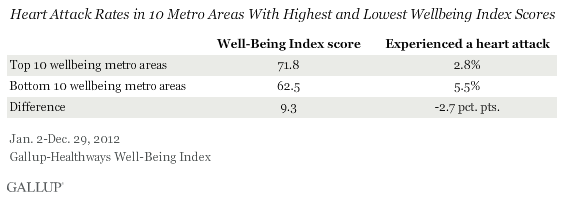
People who live in U.S. cities with low levels of well-being have twice the rate of heart attacks as people who live in healthier America. That’s 5.5% of the population in sicker America versus 2.8% of the population living in healthy America. The first chart illustrates this disparity, taken from the Gallup-Healthways index that examined 190 metropolitan areas in 2012. Based on this study, it’s good to live in parts of Utah, Nebraska and Colorado, but not so healthy to be a resident in West Virginia, Alabama, and parts of Kentucky and Ohio.
Heart disease and diabetes are killing a plurality of Americans.
But these risk factors for eventual death are both largely amenable — that is, fix-able — through lifestyle changes. That requires, in simple terms, people making different choices about what we eat, how much we move around, and tracking a few health numbers like weight, blood sugar, blood pressure, and cholesterol.
 Dr. Dean Ornish knows a lot about heart disease and diabetes. He’s studied it as much as any researcher on the planet, has written best-selling books on the topic, and most importantly has the evidence proving how making specific changes in lifestyle directly impacts — even reverses — heart disease.
Dr. Dean Ornish knows a lot about heart disease and diabetes. He’s studied it as much as any researcher on the planet, has written best-selling books on the topic, and most importantly has the evidence proving how making specific changes in lifestyle directly impacts — even reverses — heart disease.
And now Dr. Ornish’s program will be the “Ornish inside” Healthways‘ well-being improvement program.
In 2011, Medicare — known for intense scrutiny before approving payment for new programs — approved Dr. Ornish’s program for reversing heart disease — reimbursement under a new benefit category called “intensive cardiac rehabilitation.”
Dr. Ornish is also thought to be one of the inspirations behind President Bill Clinton’s motivation to abandon his fast food habit and turn into a card-carrying vegan.
Health Populi’s Hot Points: The bet that Healthways is making is that it can scale Dr. Ornish’s approach and his brand to lots more consumers than the Dr. Ornish organization can do on its own.
A prime opportunity is the employee wellness market, where employers are spending more in and beyond 2013 for more effective population health management programs that move the needle on weight/BMI and health behaviors. After years of providing discounts for gyms and Jenny Craig, employers are getting much more focused on evidence-based programs for health management.
The #1 priority for employee health benefits managers is motivating and helping sustain workers’ positive health behaviors, according to Aon Hewitt. Furthermore, the top 3 risk behaviors cited by employers are diabetes, coronary heart disease and hypertension – the very issues on which Dr. Ornish focuses.
The Dr. Ornish-inside strategy of Healthways will serve this large market. Medicare’s decision to cover Dr. Ornish’s program was based on the clinical evidence that the approach worked in individuals by people making and sticking to the tough choices in changing their food and fitness regimens. There are many successful N’s of 1 who have adopted the Ornish way-of-life and are living longer and better because of those choices.
But as the Gallup-Healthways Index points out this month, heart disease is epidemic in some of the least-healthful regions of America. So while many Amazon book buyers and switched-on empowered patients in Manhattan, Chicago and San Francisco know all about Dr. Ornish, there is heavy-lifting to be done in places where the social environment, food and transportation systems, and education attainment may mitigate against healthy hearts and glucose levels. Healthways can work with local health systems and clinics, along with local grocers, to deliver the messages of healthier proteins (like various wild fish, let alone tofu, tempeh and edamame) and the merits of fish oil and Stevia.
If Healthways can do this on more of a mass scale, they’ll do more than move the needle on employee health: they’ll impact public health in those communities as the individuals living the Ornish life socialize their health in their families, workplaces, and towns.




 Interviewed live on BNN Bloomberg (Canada) on the market for GLP-1 drugs for weight loss and their impact on both the health care system and consumer goods and services -- notably, food, nutrition, retail health, gyms, and other sectors.
Interviewed live on BNN Bloomberg (Canada) on the market for GLP-1 drugs for weight loss and their impact on both the health care system and consumer goods and services -- notably, food, nutrition, retail health, gyms, and other sectors. Thank you, Feedspot, for
Thank you, Feedspot, for  As you may know, I have been splitting work- and living-time between the U.S. and the E.U., most recently living in and working from Brussels. In the month of September 2024, I'll be splitting time between London and other parts of the U.K., and Italy where I'll be working with clients on consumer health, self-care and home care focused on food-as-medicine, digital health, business and scenario planning for the future...
As you may know, I have been splitting work- and living-time between the U.S. and the E.U., most recently living in and working from Brussels. In the month of September 2024, I'll be splitting time between London and other parts of the U.K., and Italy where I'll be working with clients on consumer health, self-care and home care focused on food-as-medicine, digital health, business and scenario planning for the future...